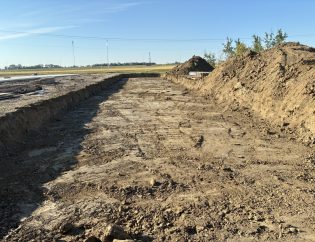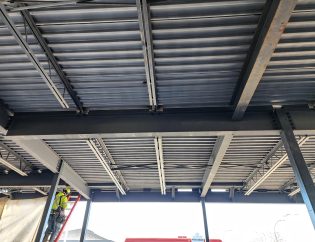Engineering is evolving, and predictive analytics is at the forefront of this transformation. By combining advanced algorithms and artificial intelligence, engineers can now anticipate structural issues before they occur, ensuring safety and efficiency in ways once thought impossible. This shift is revolutionizing how industries approach maintenance and design.
AI-driven predictive models analyze vast amounts of data from sensors and simulations, identifying patterns that signal potential weaknesses or failures. Whether it’s bridges, buildings, or machinery, these insights empower engineers to make proactive decisions, saving time, resources, and even lives. As technology advances, the role of predictive analytics in maintaining structural integrity continues to grow, shaping a smarter, safer future—just as innovations in sectors like Merkur Leicester demonstrate how tech can redefine both safety and user experience.
Understanding Predictive Analytics in Engineering
Predictive analytics is transforming engineering processes by integrating data-driven insights with AI technologies. This approach allows engineers to foresee potential structural failures and optimize design and maintenance strategies effectively. Interestingly, similar data-driven methodologies are also being applied in fields like iGaming, where first-time deposit strategies leverage predictive insights to enhance user acquisition and retention.
What Is Predictive Analytics?
Predictive analytics refers to the application of statistical algorithms, data mining, and machine learning to anticipate future outcomes. In engineering, it involves analyzing historical and real-time data from sensors, models, and simulations to predict system performance. It enables actionable insights by addressing issues such as material fatigue, stress points, and operational lifespan.
The Role of AI in Structural Integrity
Artificial intelligence enhances predictive analytics by processing vast datasets with precision. Machine learning algorithms identify hidden patterns in structural behavior and environmental impacts. AI-powered tools simulate stress reactions in infrastructure, helping engineers evaluate durability under different conditions. This ensures safety and reduces costs by enabling preemptive interventions.
| Key Applications | Examples |
|---|---|
| Structural Health Monitoring | Bridges, dams, and skyscrapers |
| Failure Prediction | Engines, turbines, pipelines |
| Design Optimization | Construction materials and load testing |
| Real-Time Data Analysis | IoT sensor networks on critical assets |
For more on AI’s role in predictive analytics, refer to MIT Technology Review.
Key Components of AI-Driven Structural Analysis
AI-powered systems transform how engineers evaluate and maintain structural integrity. By combining advanced technologies, they enhance predictive accuracy, ensuring safer and more resilient designs.
Machine Learning Models
Machine learning models are central to AI-driven structural analysis. They simulate complex systems, predict failure modes, and optimize structural performance under varying conditions. Leveraging large-scale datasets, these algorithms identify potential vulnerabilities and improve safety and durability. Techniques like supervised learning analyze historical failure patterns, while unsupervised models find hidden anomalies, enabling engineers to address risks early.
Data Collection and Processing
Effective data collection ensures AI models deliver actionable insights. Engineers use sensors to gather information about load, stress, and environmental factors in real time. By processing historical data alongside live inputs, AI systems create detailed structural models. Data streams from IoT networks and smart devices help analyze trends, offering a complete view of material wear, damage rates, or sudden stress changes.
Real-Time Monitoring Tools
Monitoring tools track structural health continuously, providing critical updates. Tools integrated with AI evaluate vibrations, strain, and temperature variations, allowing immediate responses to abnormalities. Real-time monitoring reduces long-term costs by detecting issues early. Systems like digital twins visualize performance under diverse conditions, streamlining maintenance schedules and keeping infrastructure operational.
Implementation in Key Applications
| Application | AI Utilization | Benefit |
|---|---|---|
| Bridges and Buildings | IoT sensors provide live data for stress and fatigue detection | Prevents failures and ensures safety |
| Pipelines and Machinery | Machine learning analyzes pressure flows and operational patterns | Predicts breakdowns, reducing downtime |
| Construction Material Optimization | AI models simulate material performance under various loads and environmental factors | Promotes cost-effective, high-quality designs |
For a comprehensive jump into AI’s integration in predictive engineering, explore insights from MIT Technology Review.
Applications of Predictive Analytics in Structural Integrity
Predictive analytics, combined with AI, transforms engineering by enabling early detection of structural issues. Its applications ensure proactive measures, minimizing risks and extending asset lifespans.
Predicting Material Fatigue and Failure
Advanced AI tools analyze historical and real-time data to identify material fatigue and possible failure modes. Structural analysis software simulates behaviors under diverse loads, providing detailed insights. Non-Destructive Evaluation techniques like ultrasonic, radiographic, and electromagnetic testing detect anomalies seamlessly. These methods equip engineers to act before irreversible damage occurs, reducing downtime and repair costs.
Optimizing Maintenance Schedules
AI-powered predictive analytics optimizes maintenance schedules by evaluating sensor data and operational patterns. With real-time monitoring of assets like bridges and machinery, engineers can predict optimal times for interventions. Scheduled maintenance based on predictive insights extends life cycles and avoids unnecessary costs. This systematic approach enhances operational efficiency while prioritizing critical repairs.
Enhancing Safety Standards
AI technologies ensure compliance with safety standards by forecasting potential hazards. Predictive models identify weak points in infrastructures such as pipelines and high-rise structures. Real-time environmental data like stress and temperature variations offer preventative measures. These tools help governments and private sectors enhance safety protocols and preserve public and workforce safety.
| Applications | Techniques Used | Benefits |
|---|---|---|
| Material fatigue prediction | NDE (ultrasonic, radiographic), AI models | Early anomaly detection, reduced failures |
| Maintenance schedule optimization | IoT sensors, real-time monitoring | Cost-effective repairs, increased efficiency |
| Safety standards enhancement | Predictive models, analytic simulations | Reduced hazards, adherence to safety codes |
For further insights, explore predictive analytics in structural engineering outlined by the MIT Technology Review.
Benefits of Leveraging AI for Structural Integrity
AI technologies are revolutionizing structural engineering by enabling cost savings, mitigating risks, and enhancing the durability of critical assets. These benefits contribute to smarter designs, safer structures, and efficient maintenance strategies.
Cost Efficiency
AI-driven tools streamline processes by automating data analysis from Non-Destructive Evaluation measurements and sensors. Automation reduces the need for manual intervention, cutting both time and labor costs. Advanced algorithms also optimize structural designs and simulations, saving expenses on physical prototypes. Supporting methods like finite element analysis further enhance these efficiencies. According to a report by McKinsey, automation can reduce engineering costs by 10-15%.
Improved Risk Management
Predictive analytics with AI enhances risk identification by analyzing sensor data and real-time conditions to pinpoint structural vulnerabilities. It provides engineers with actionable insights to fix potential issues before they escalate. For example, AI solutions in bridge health monitoring detect stress and load anomalies, allowing timely maintenance to avoid catastrophic failures. Advanced insights also improve compliance with safety standards, reducing liability risks.
Increased Operational Lifespan
By using machine learning to predict material fatigue and stress, AI extends the lifespan of structures. Continuous monitoring of infrastructure through IoT sensors ensures timely detection of degradation. Early diagnosis facilitates preventive repairs, which enhance longevity and reduce frequent replacements. Skyscrapers and pipelines equipped with these technologies show significantly lower failure rates, leading to long-term operational sustainability.
| Feature | Application | Impact |
|---|---|---|
| Automated Data Analysis | NDE measurements, sensor networks | Reduces manual labor and costs |
| Real-time Monitoring | Load, stress, environmental factors | Detects risks, enables quick action |
| Predictive Maintenance | Machinery, infrastructure | Extends operational lifespan |
For more detailed insights, explore coverage from MIT Technology Review.
Challenges and Limitations
AI-powered predictive analytics in structural engineering unlocks significant advancements, but challenges persist. Data reliability, implementation hurdles, and ethical concerns need addressing to maximize effectiveness.
Data Quality Concerns
Accurate AI models rely on high-quality data, but engineering datasets often face issues like noise, missing values, or inconsistencies. Poor data quality impacts predictive model accuracy, requiring engineers to carry out rigorous validation and preprocessing methods. For example, historical bridge stress data with inconsistencies may lead to flawed predictions, risking safety and efficiency.
| Data Quality Challenges | Effects on Predictive Analytics |
|---|---|
| Noisy Data | Reduces algorithm accuracy |
| Missing Values | Causes incomplete analysis |
| Inconsistent Datasets | Creates unreliable structural predictions |
Complexity of Implementation
Deploying AI in engineering involves complex processes like model training, validation, and integration of IoT networks. Smaller firms often struggle with this complexity due to limited technical expertise or resources. Ensuring seamless data collection from embedded sensors and coordinating real-time analytics highlight these challenges in high-stakes environments, such as monitoring skyscrapers during adverse conditions.
Ethical and Regulatory Considerations
AI use raises concerns over accountability and compliance with safety regulations. Ambiguities in ethical frameworks can lead to liability disputes in case of AI-based system failures. Engineers must ensure AI-driven recommendations adhere to current codes and standards, reducing legal risks. For further insights, refer to guidelines by American Society of Civil Engineers (ASCE).
Future Outlook for Predictive Analytics in Engineering
Predictive analytics in engineering continues to evolve with rapid advancements in AI. These innovations reshape structural integrity assessments, prioritizing safety and efficiency while addressing new challenges.
Emerging Technologies and Trends
AI-integrated tools lead the development of predictive maintenance solutions. Advances in IoT sensors enable engineers to collect real-time data, enhancing precision in structural monitoring. Machine learning algorithms analyze this data to detect stress fractures, material fatigue, and potential failure points. Digital twins, virtual models replicating physical assets, are emerging as essential tools for simulating and predicting structural behavior under varying conditions. Cloud computing supports these technologies by processing vast datasets faster, improving predictions and decision-making.
| Technology | Application in Predictive Analytics | Impact |
|---|---|---|
| IoT Sensors | Collecting real-time structural data | Improves accuracy in monitoring |
| Machine Learning | Analyzing patterns in historical and live data | Detects potential issues early |
| Digital Twins | Simulating structural conditions and performance | Enhances maintenance planning |
| Cloud Computing | Storing and processing large engineering datasets | Increases efficiency of data analysis |
Expansion into New Engineering Domains
Predictive analytics moves beyond traditional applications like structural health monitoring to impact diverse engineering fields. In aerospace, machine learning models optimize aircraft part maintenance by predicting wear and tear. Civil engineers leverage AI to address dynamic challenges in urban infrastructure management, integrating predictive tools for sustainable designs. Similarly, oil and gas industries use IoT-backed predictive systems to monitor pipelines, reducing failures and ensuring safety. Emerging domains like renewable energy also adopt predictive models, focusing on wind turbine and solar panel efficiency.
Advancing AI implementation in these sectors creates opportunities to mitigate risks and optimize asset performance across industries.
Conclusion
Predictive analytics powered by AI is revolutionizing structural integrity in engineering, offering unparalleled precision and efficiency. By harnessing advanced technologies like machine learning, IoT sensors, and digital twins, engineers can proactively address potential failures, optimize designs, and extend the lifespan of critical infrastructure.
While challenges such as data reliability and implementation complexity remain, ongoing advancements in AI are paving the way for smarter, safer, and more sustainable engineering practices. As industries continue to adopt these innovations, predictive analytics will play an increasingly vital role in shaping a resilient future.









